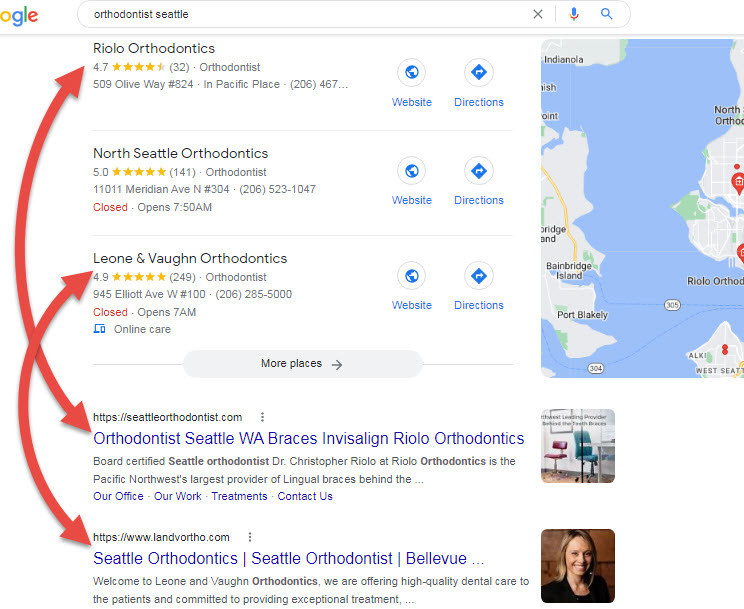Either you’ve got multiple business locations that you want to rank well throughout as much turf as possible, or you’ve got one location and the same goal. You may be somewhat more focused on the Google Maps / 3-pack results, but you also want the maximum local visibility in the organic results. In either case you probably want to know what actions can help you in multiple areas at once, and what can help you in one problem area or another.
How can you feed the whole nest of birds at once, and how can you feed the one extra-scrawny bird? You probably plan to do both, but if you can’t tell the two apart, you can’t put your time, resources, and effort to the best use now.
What do I mean by “help”? Either bumping up your rankings for terms you already rank (badly) for, or starting to rank for new terms or in new cities/areas where you’re not even on the scoreboard yet.
As you go through the two quick bullet-point lists below, there are 3 basic concepts to keep in mind, which will help make sense of it all:
- Any work on business listings (Google Business Profile / Google My Business and citations) and reviews only helps one location, typically.
- Any work on the site or on backlinks can help multiple locations, particularly if you have multiple GBP / GMB pages that all point to the same website domain.
- Much of your Maps visibility depends on your organic SEO (i.e. site + links).

Steps that can help multiple locations at once (in the Google Maps or organic results or both):
- Getting good inbound links (particularly if they point to the homepage or another page you use as the landing page URL for multiple GMB pages).
- Adding service-related content to the landing page URL(s) you use for GMB. Usually that’s your homepage, but not
- Adding content about your service area to the landing page URL(s) you use for GMB. Describe your service area in detail, and go beyond that if you can.
- Creating, expanding, or improving service, product, or bio pages.
- Removing (from the map) widely visible, dominant spammy competitors. Often they cut into your visibility in multiple areas, or across a large metro area.
- Writing a stronger homepage title tag.
- Adding footer links or other site-wide links to “location” pages, or describing your service area in detail in the footer, or both.
- Standardizing all pages’ title tags so that they all mention your highest-priority services or products, or your highest-priority locations, or both.
Steps that only help one location (in the Google Maps results):
- Getting reviews. People can only review one business at a time, one location at a time.
- Improving the landing page URL on your site, whether it’s your homepage or a location page.
- Squaring away your GMB page: getting the landing page URL right, picking the best category or categories, and not mangling the service-area settings (if applicable).
- Adding keywords to the GMB name. Not saying you should, though.
- Getting a GMB page unsuspended. The status of another page doesn’t affect the one that’s suspended, and vice versa.
- Building or fixing citations.
- Moving to a different address. Or that can hurt you, depending on how and why you choose to relocate.
- Removing smaller, less-dominant spammy competitors.
Any questions or puzzles?
Leave a comment!

I would be interested to know your thoughts on this…
We have several clients with higher DR ratings and higher referring domain counts, yet are outranked in maps by competitors with disproportionately low DR ratings and referring domain counts.
More of a theory question… what would say causes businesses with substantially lower authority and referring domains to reach the #1 map ranking – or top 3 – in highly competitive markets in large metro areas?
Thank you for the great content!
Thanks, Bobby.
Great question. Here’s what I’d look at:
1. For which terms do the lower-DR competitors rank? (I bet it’s not all of them.) See https://www.localvisibilitysystem.com/2022/01/31/realistic-rankings-radii-in-local-seo/
2. They rank that way according to what? See https://www.localvisibilitysystem.com/2017/05/24/did-your-local-rankings-really-sink-or-are-you-just-looking-at-them-wrong/
3. Have they been around much longer?
4. To what extent are they spamming?
5. Are they using the homepage as the GMB landing page URL, whereas you’re using a “location” page?
6. Have they squeezed more out of the title tag of their GMB landing page URL? See https://www.localvisibilitysystem.com/2022/06/29/21-local-seo-moves-situations-i-have-never-seen-a-business-penalized-for/
7. In general, are their good links more relevant? Often a site with links from big, well-known sites that are not focused on a particular industry or region will get smoked by a site with some solid “local” links and only a couple of links from sites important in its industry.
Lots of things one can look into, of course, but those are what I’ve found to be the likely suspects.
Great response, and I have a ton of additional reading via your links (which I’ve already read a few of them).
Using ahrefs and looking at the referring domains of the one particular business that’s super low comparatively in DR and referring domain count… here’s the common denominator / take away that I observe – and possibly the key components fueling their rankings, at least for one of the main search terms:
1) the majority of their referring domains look like they are coming from citations… I haven’t gone one by one to get exact %, but just eyeballing it that looks to be case
2) I did count the number of citations they have from niche specific directories and it’s about 20% — so 20% of their total referral domain count is found within niche specific citations
3) of their top 3 most authoritative referring domains, 2 of the 3 are coming from citations within very niche specific directories
4) they are members of 3 chambers of commerce within their city, and they have citations for each… these chamber sites by no means are the in the top tier most authoritative referring domains, but they are hyper relevant to the city, and in turn authoritative in that manner (location authority specific citations via chambers… 3 of them).
In summary, and boiling down to common denominators:
1) high concentration % of niche relevant directory citations
2) members of local chambers of commerce / hyper local relevant citations
3) the links coming from those 2 of the 3 higher DR referring domains are all do follow
** thank you again Phil, and I very much look forward to diving in to the referenced articles you shared in your comment!
Hey Bobby,
That sounds about right. Good fact-finding.
At least from up here in the cheap seats, I’m pretty certain #4 is where the leverage is, and #3 to a lesser extent. Many niche citation sources not only give you a followed link, but one that’s locally relevant. Even when their DR/DA is low, those locally relevant domains really pack a punch, especially in numbers. The chamber of commerce links are always particularly good. For rankings purposes and just for cultivating tiny non-Google sources of visibility, I’d take 10 of those links over 1 super-prominent “whale” link every time.
Hi again Phil… one more quick question for you to see what you think…
do you have any thoughts on purchasing expiring domains as a strategy for acquiring high value backlinks — either hype local links and / or high authority links?
For example if a domain was expiring and I acquire it, and it have links from wikipedia and NYTimes, etc…
And / or if the site was hyper local and had links from a client’s city like from the chamber of commerce, local news sites, etc…
Would you advocate this as a solid strategy to acquire these domains, then 301 to a client’s site as a link acquisition strategy?
thank you again sir
Bobby
I’ve seen that work well in a couple of cases. Probably wouldn’t rely on the expired domains as a major part of your strategy. But if you’re scrounging links through a variety of means, and especially if you also try to recreate whatever valuable content earned the previous owner the good link in the first place, then it has a place in the golf bag.
Great post, informative and helpful as always.
Jim Allen
Thanks, Jim.
Thanks for this post Phil. Some of it I know already from your previous posts, but the multi-locations aspect is very timely as I just spoke to a client about fixing their multiple shop listings today, and your advice answers a few important questions.
G’day, Tamhas.
My pleasure, and thanks for the feedback.